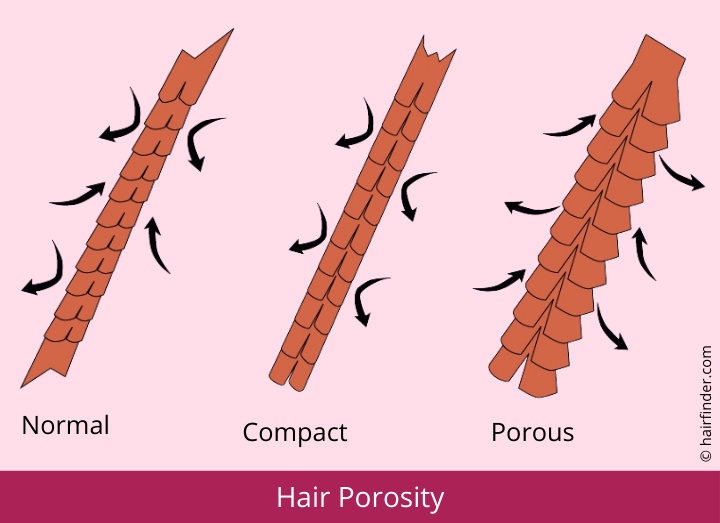8/27/11
What is Hair Porosity?
I'm glad you guys enjoyed the previous 'Hair Science' post about pH Balance & why it's important to hair care. I feel it's important we know the basic science of our hair so that we can understand it better resulting in caring for it better. One thing a lot of females don't realize about their own hair porosity. When you have a better understanding of your hair porosity you will be able to find products that work better for your hair.
Porosity refers to the ability of your hair to absorb moisture and is determined by the state the cuticle of your hair is in. Porosity is a critically important factor in determining curly hair care since moisture is what shapes and defines our curls. If you don't know your hair's porosity, you won't be able to make the best product and maintenance routine choices to maximize the amount of moisture your curls retain. The existing "curl classification systems" never seem to mention porosity in their categorization process. Odd, considering lack of moisture is one of the biggest causes of frizz, the demon of Curly World.
There are three different classifications of porosity:
Low Porosity
Low porosity is when the cuticle of the hair shaft is too compact and does not permit moisture to enter or leave the hair shaft. Hair with low porosity is much more difficult to process, is resistant to chemical services, and has a tendency to repel product rather than absorb it. Low porosity hair is often quite shiny, especially if it is a darker color. Overall this type of hair is considered to be quite healthy. If your hair repels water when you attempt to wet it, that is a good indication that it has low porosity. It can be quite difficult to process, because it resists penetration of the chemicals being used.
Low porosity hair is more prone to an excessive accumulation of protein if deep conditioning products are used and will feel very stiff and straw-like. It requires products rich in moisture and emollients and also benefits most from products that contain humectants, which attract moisture to the hair and hold it there. If hair with very few or very small openings becomes dry for some reason, it can be more difficult to restore proper moisture balance to it. In this case, a deep conditioning treatment with moderate heat would be a good way to ensure the cuticle is sufficiently opened up to allow moisture to enter into the cortex.
Normal Porosity
With normal porosity, the cuticle is compact and inhibits moisture from leaving or entering the hair shaft; however, it allows for normal processing when a chemical service is performed and will readily absorb and retain product properly formulated for this hair type. Normal porosity hair has a tendency to hold styles well. Perming or coloring can be done in a predictable manner, following the usual guidelines of the product. However, one must note that these processes will damage the hair and increase its porosity over time. An occasional deep conditioning treatment with a protein-containing product will be of benefit, but proteins should not be included in the daily regimen.
High Porosity
Hair with high porosity, also known as “overly porous” hair, has an open cuticle that both absorbs and releases moisture easily. Overly porous hair processes very quickly and can be easily damaged if extreme care is not taken when a chemical service is performed. Although overly porous hair absorbs product quickly, it is often dry as the open cuticle does not allow for product retention within the hair shaft.
Hair with a great deal of porosity has been found to be capable of absorbing significantly higher amounts of water than hair or normal or low porosity (up to 55%, in contrast with 31.1% for healthy hair). Excessive absorption of water from the atmosphere causes frizz and tangling on humid days. Total immersion of high porosity hair during bathing, swimming, or shampooing can lead to significant breakage due to loss of elasticity from the sheer weight of the water absorbed. It also takes on color much more quickly and in higher concentrations than normal porosity hair when undergoing a chemical color process.
People with high porosity hair should use products with lots of moisturizers and emollients and also use anti-humectants in high heat and humidity climates in order to seal their cuticle against excessive absorption of moisture from the air. Protein treatments can also be very helpful for patching some of the holes in the hair, but one must follow up with moisturizing products in order to avoid a stiff texture. Rinsing with a slightly acidic rinse will help flatten and seal the cuticle. Some clear color applications have proteins in them than can patch the gaps in your hair also. Consult your professional hair stylist for more information about such products.
How To Check Your Porosity
You can check porosity on dry hair by taking a strand of several hairs from four different areas of the head (front hairline, temple, crown and nape). Slide the thumb and index finger of your other hand down each hair strand from end to scalp. If it is smooth, you have normal porosity. If your fingers move very fast up the hair strand and it feels exceptionally slick, dense and hard, you have low porosity. If your fingers "catch" going up the strand, feel like they are ruffling up the hair strand, or if the hair strand breaks, your hair is overly porous.
via Live Curly, Live Free & NaturallyCurly.com
Subscribe to:
Post Comments (Atom)


No comments:
Post a Comment